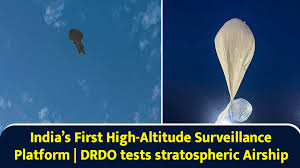My article was published on “The EurasianTimes” website
on 05 May 25.
On May 3, 2025, India’s Defence Research and Development Organisation (DRDO) achieved a significant milestone by successfully conducting the maiden flight trial of its Stratospheric Airship Platform at Sheopur, Madhya Pradesh. Developed by the Aerial Delivery Research and Development Establishment (ADRDE) in Agra, the lighter-than-air platform reached an altitude of 17 km, carrying an instrumental payload during a 62-minute flight. The test validated critical systems, including envelope pressure control and emergency deflation mechanisms, with sensor data collected to refine high-fidelity simulation models for future missions. Defence Minister Rajnath Singh and DRDO Chairman Dr. Samir V. Kamat hailed the achievement, emphasising its potential to enhance India’s earth observation, intelligence, surveillance, and reconnaissance (ISR) capabilities. This positions India among a select few nations with indigenous stratospheric airship technology. The successful trial, conducted amid heightened India-Pakistan tensions, underscores DRDO’s focus on advancing high-altitude, long-endurance platforms to bolster national security and surveillance, marking a pivotal step toward operationalising these pseudo-satellite systems.
Stratospheric Airships
In an era where connectivity, surveillance, and environmental monitoring are paramount, the innovative stratospheric airship platforms, high-altitude, lighter-than-air vehicles operating at 20–30 km, offer a transformative solution. These unmanned, long-endurance systems, often called High-Altitude Platform Systems (HAPS), combine satellites’ endurance with terrestrial systems’ flexibility. Positioned above commercial air traffic and weather systems, they promise to deliver telecommunications, intelligence, surveillance, reconnaissance (ISR), and scientific research at a fraction of the cost of traditional satellites.
Technology. Stratospheric airships are aerostatic vehicles that rely on helium-filled envelopes for buoyancy, allowing them to float in the low-density air of the stratosphere. Unlike fixed-wing HAPS or balloons, airships use propulsion systems, typically electric motors powered by solar panels or hydrogen-based regenerative fuel cells (RFCs), to maintain station-keeping or navigate over specific regions. Their design incorporates lightweight, UV-resistant materials to withstand harsh stratospheric conditions, including temperatures as low as -60°C, intense ultraviolet radiation, and ozone corrosion.
Components. The primary technical challenges include developing lightweight materials, optimising energy efficiency, ensuring thermal management, and achieving reliable control in a near-vacuum environment. These hurdles have historically delayed operational deployment, but recent advancements are closing the gap. Key technological components include:-
-
- Envelope and Materials. The helium-filled envelope, often made of advanced composites like polyethene or Mylar, must balance strength, weight, and durability. Innovations in nanotechnology and multi-layered fabrics enhance resistance to environmental degradation.
- Power Systems. Solar panels and energy storage (batteries or RFCs) enable continuous operation. RFCs, which generate electricity by combining hydrogen and oxygen, are particularly promising for long-endurance missions, as demonstrated in Japan’s Stratospheric Platform (SPF) program.
- Payload. Airships carry modular payloads (20–1,500 kg) tailored to specific missions, such as phased-array antennas for 4G/5G connectivity, high-resolution cameras for ISR, or sensors for environmental monitoring.
- Control Systems. Autonomous navigation and station-keeping require sophisticated algorithms to counter stratospheric winds, which are milder than jet streams but still challenging. Machine learning and real-time data processing are increasingly integrated for precision.
Applications
Stratospheric airships are versatile platforms with applications across civilian, commercial, and military domains. These applications position stratospheric airships as a cost-effective alternative to satellites, with the added benefit of reusability and rapid deployment.
Telecommunications. Airships can provide broadband connectivity to remote or underserved regions, acting as “pseudo-satellites.” For instance, Mira Aerospace’s ApusDuo HAPS delivered 5G connectivity in Rwanda in 2023, demonstrating the potential to bridge the digital divide. Unlike satellites, airships can be repositioned or serviced, offering flexibility for dynamic network demands.
Intelligence, Surveillance, Reconnaissance (ISR). Their ability to loiter over specific areas for extended periods makes airships ideal for ISR.
Environmental Monitoring. Airships with sensors can monitor greenhouse gases, climate patterns, or natural disasters. Sceye Inc., a New Mexico-based company, is developing airships to track environmental changes, supporting global sustainability efforts.
Scientific Research. High-altitude platforms enable ground-breaking scientific research, such as atmospheric studies, astronomy, and other research requiring stable, high-altitude vantage points. NASA’s proposed Centennial Challenge aims to incentivise airship innovations for scientific missions, inspiring a new era of discovery.
Military Applications. Beyond ISR, airships could support GPS jamming, missile defence, wartime communications, electronic warfare and the potential for stealth detection.
Advantages & Limitations
Advantages. Stratospheric airships provide compelling advantages over traditional platforms like satellites. Their cost-effectiveness is a key benefit, with development, launch, and maintenance costs in the millions, far below the billions required for satellites. This affordability democratises access to high-altitude capabilities. Flexibility is another strength; unlike geostationary satellites, airships can be repositioned, serviced, or upgraded to meet evolving mission needs, enabling dynamic applications such as telecommunications or surveillance. Their long endurance—capable of missions lasting months or even years—reduces the need for frequent replacements, enhancing operational efficiency. Additionally, accessibility is improved by operating below orbital altitudes, avoiding the complexities of space debris and stringent international space regulations. These attributes make stratospheric airships an attractive alternative for tasks like broadband delivery, environmental monitoring, and intelligence gathering, offering a versatile, cost-efficient bridge between terrestrial and space-based systems.
Limitations. Stratospheric airship platforms face significant limitations that hinder their widespread adoption. Technical complexity remains a primary challenge, as lightweight materials, efficient energy storage, and precise control systems require further development to ensure reliability in the harsh stratospheric environment. Limited operational systems exacerbate this issue, with most airships still in the prototype phase and scarce real-world flight data to validate performance. Environmental challenges also pose risks, as stratospheric conditions—extreme cold, UV radiation, and ozone exposure—demand robust designs to prevent envelope degradation or thermal failures. Additionally, regulatory hurdles complicate deployment, as coordinating airspace usage and navigating international regulations, particularly for cross-border missions, remains a barrier. These challenges necessitate substantial investment in research, testing, and regulatory frameworks to transition stratospheric airships from experimental to operational systems, unlocking their potential for telecommunications, surveillance, and environmental monitoring.
Development status
The concept of stratospheric airships, pioneered in the 1960s with Raven Aerostar’s High Platform II reaching 70,000 ft in 1969, gained traction in the 1990s as materials and solar technology advanced. Despite high costs and complexity, recent global efforts signal a resurgence, driven by improved designs and commercial potential, as seen in Google’s Loon (2013–2021).
United States. The U.S. pursued stratospheric airships through Lockheed Martin’s High Altitude Airship (HAA) and DARPA’s ISIS for ISR, but both were cancelled due to cost overruns. Aerostar’s HiSentinel reached 74,000 ft in 2005, proving viability. Sceye Inc. now leads the scaling of solar-powered airships in New Mexico for broadband and environmental monitoring, with expansion planned for 2025.
Japan. Japan’s JAXA launched the Stratospheric Platform (SPF) in the 1990s, focusing on solar-powered airships with regenerative fuel cells. Prototypes were tested, but the program shifted focus by 2009. Japan’s early work on energy systems remains influential for long-endurance HAPS development.
South Korea and Europe. South Korea explored HAPS in the 2000s with limited outcomes. In Europe, Thales Alenia Space’s Stratobus targets ISR and telecom, aiming for five-year missions with a 2023 prototype. The TAO Group’s SkyDragon introduces a segmented design for stability, enhancing European innovation.
China. China’s Yuanmeng airship, tested in 2015, focuses on military surveillance and stealth detection. Ongoing programs by the Aviation Industry Corporation of China emphasise long-endurance airships for communication and reconnaissance.
Future Prospects
The future of stratospheric airships is bright, driven by technological advancements. Innovations in nanotechnology and composite fabrics will produce lighter, more durable envelopes, extending mission durations. Next-generation regenerative fuel cells (RFCs) and high-efficiency solar cells will ensure reliable power, critical for continuous operation in the stratosphere. Enhanced by machine learning and real-time wind modelling, autonomous control systems will improve station-keeping precision, minimising energy use. These developments will enable airships to loiter for months or years, offering cost-effective alternatives to satellites. By addressing technical challenges, stratospheric airships are poised to revolutionise telecommunications, surveillance, and environmental monitoring by 2030.
Commercialisation and global collaboration are accelerating progress. Companies like Sceye and Stratospheric Platforms are securing investments, reflecting market confidence in high-altitude platform systems (HAPS) for connectivity and monitoring. NASA’s proposed Centennial Challenge could spur international innovation, while public-private partnerships may streamline development. However, scaling production, reducing costs, and validating reliability through extended flight tests remain critical hurdles. If overcome, stratospheric airships could become mainstream solutions, particularly in regions lacking satellite or terrestrial infrastructure, transforming global access to data and security.
Conclusion
Stratospheric airship platforms represent a frontier in high-altitude technology, blending satellites’ endurance with terrestrial systems’ adaptability. From providing broadband in remote areas to enhancing military surveillance and monitoring climate change, their applications are vast and transformative. While historical efforts faced setbacks, recent advancements, such as India’s 2025 test, Sceye’s commercial push, and Thales’ Stratobus, signal a new era of viability. As materials, energy systems, and controls evolve, stratospheric airships are poised to redefine global connectivity, security, and scientific exploration, soaring to new heights in the decades ahead.
Please Add Value to the write-up with your views on the subject.
For regular updates, please register your email here:-
References and credits
To all the online sites and channels.
Pics Courtesy: Internet
Disclaimer:
Information and data included in the blog are for educational & non-commercial purposes only and have been carefully adapted, excerpted, or edited from reliable and accurate sources. All copyrighted material belongs to respective owners and is provided only for wider dissemination.
References:-
- Aerial Delivery Research and Development Establishment. (2025, May 4). DRDO conducts maiden flight trial of stratospheric airship platform. Press Release, Defence Research and Development Organisation. https://www.drdo.gov.in/press-release/drdo-conducts-maiden-flight-trial-stratospheric-airship-platform
- Boucher, R. J. (1985). History of solar-powered airships: From High Platform II to modern HAPS. Journal of Aerospace Engineering, 1(2), 45–56. https://doi.org/10.1061/(ASCE)0893-1321(1985)1:2(45)
- Chen, L., & Zhang, H. (2016). Development of the Yuanmeng stratospheric airship for military applications. Chinese Journal of Aeronautics, 29(4), 912–920. https://doi.org/10.1016/j.cja.2016.06.015
- Colozza, A., & Dolce, J. L. (2005). High-altitude airship platform systems: Technical challenges and opportunities. NASA Technical Report, NASA/TM-2005-213427. https://ntrs.nasa.gov/citations/20050182976
- Japan Aerospace Exploration Agency. (2009). Stratospheric Platform (SPF) program: Final report on solar-powered airship prototypes. JAXA Technical Report, JAXA-RR-09-012. https://www.jaxa.jp/publications/
- Mira Aerospace. (2023, August 15). ApusDuo HAPS delivers 5G connectivity in Rwanda. Aerospace Technology News. https://www.aerospacetechnews.com/mira-aerospace-apusduo-5g-rwanda-2023
- Sceye Inc. (2024, December 10). Sceye advances stratospheric airship production for broadband and environmental monitoring. Business Wire. https://www.businesswire.com/news/sceye-stratospheric-airship-expansion-2025
- Thales Alenia Space. (2023, June 20). Stratobus: Progress toward 2023 prototype for ISR and telecommunications. Thales Group Press Release. https://www.thalesgroup.com/en/stratobus-2023-prototype-update
- Tozer, T. C., & Grace, D. (2001). High-altitude platforms for wireless communications. Electronics & Communication Engineering Journal, 13(3), 127–137. https://doi.org/10.1049/ecej:20010303
- Yang, Y., & Wu, J. (2018). Advancements in regenerative fuel cells for stratospheric airships. Energy Conversion and Management, 175, 89–98. https://doi.org/10.1016/j.enconman.2018.08.072



